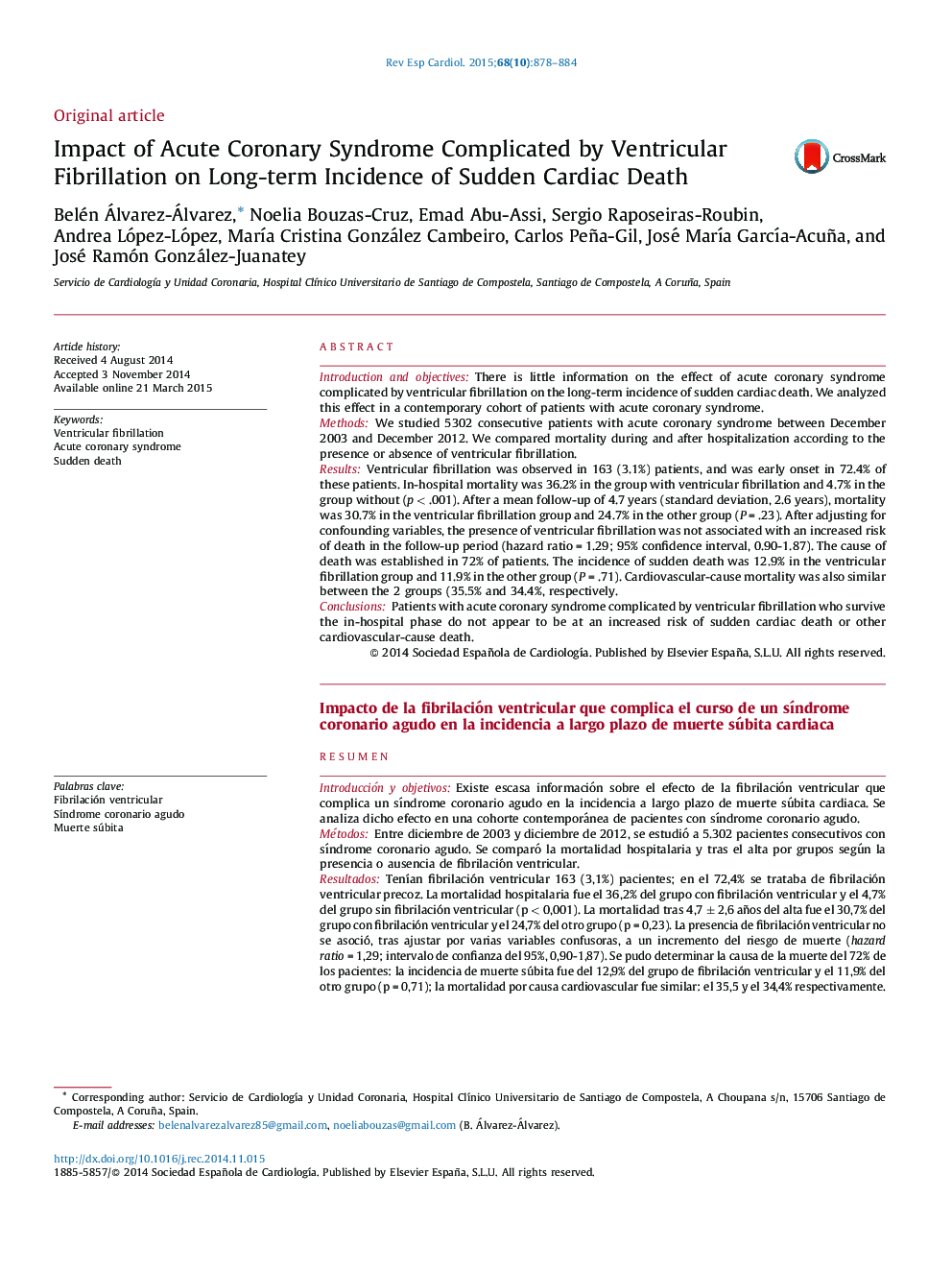| Article ID | Journal | Published Year | Pages | File Type |
|---|---|---|---|---|
| 3016274 | Revista Española de Cardiología (English Edition) | 2015 | 7 Pages |
Introduction and objectivesThere is little information on the effect of acute coronary syndrome complicated by ventricular fibrillation on the long-term incidence of sudden cardiac death. We analyzed this effect in a contemporary cohort of patients with acute coronary syndrome.MethodsWe studied 5302 consecutive patients with acute coronary syndrome between December 2003 and December 2012. We compared mortality during and after hospitalization according to the presence or absence of ventricular fibrillation.ResultsVentricular fibrillation was observed in 163 (3.1%) patients, and was early onset in 72.4% of these patients. In-hospital mortality was 36.2% in the group with ventricular fibrillation and 4.7% in the group without (p < .001). After a mean follow-up of 4.7 years (standard deviation, 2.6 years), mortality was 30.7% in the ventricular fibrillation group and 24.7% in the other group (P = .23). After adjusting for confounding variables, the presence of ventricular fibrillation was not associated with an increased risk of death in the follow-up period (hazard ratio = 1.29; 95% confidence interval, 0.90-1.87). The cause of death was established in 72% of patients. The incidence of sudden death was 12.9% in the ventricular fibrillation group and 11.9% in the other group (P = .71). Cardiovascular-cause mortality was also similar between the 2 groups (35.5% and 34.4%, respectively.ConclusionsPatients with acute coronary syndrome complicated by ventricular fibrillation who survive the in-hospital phase do not appear to be at an increased risk of sudden cardiac death or other cardiovascular-cause death.
ResumenIntroducción y objetivosExiste escasa información sobre el efecto de la fibrilación ventricular que complica un síndrome coronario agudo en la incidencia a largo plazo de muerte súbita cardiaca. Se analiza dicho efecto en una cohorte contemporánea de pacientes con síndrome coronario agudo.MétodosEntre diciembre de 2003 y diciembre de 2012, se estudió a 5.302 pacientes consecutivos con síndrome coronario agudo. Se comparó la mortalidad hospitalaria y tras el alta por grupos según la presencia o ausencia de fibrilación ventricular.ResultadosTenían fibrilación ventricular 163 (3,1%) pacientes; en el 72,4% se trataba de fibrilación ventricular precoz. La mortalidad hospitalaria fue el 36,2% del grupo con fibrilación ventricular y el 4,7% del grupo sin fibrilación ventricular (p < 0,001). La mortalidad tras 4,7 ± 2,6 años del alta fue el 30,7% del grupo con fibrilación ventricular y el 24,7% del otro grupo (p = 0,23). La presencia de fibrilación ventricular no se asoció, tras ajustar por varias variables confusoras, a un incremento del riesgo de muerte (hazard ratio = 1,29; intervalo de confianza del 95%, 0,90-1,87). Se pudo determinar la causa de la muerte del 72% de los pacientes: la incidencia de muerte súbita fue del 12,9% del grupo de fibrilación ventricular y el 11,9% del otro grupo (p = 0,71); la mortalidad por causa cardiovascular fue similar: el 35,5 y el 34,4% respectivamente.ConclusionesSuperada la fase de hospitalización, no parece que haya un aumento del riesgo de muerte súbita cardiaca o de otra causa cardiovascular en los pacientes cuyo síndrome coronario agudo se complica con fibrilación ventricular.
